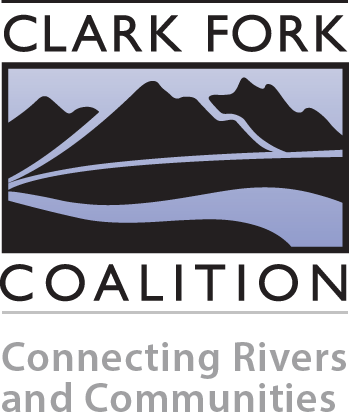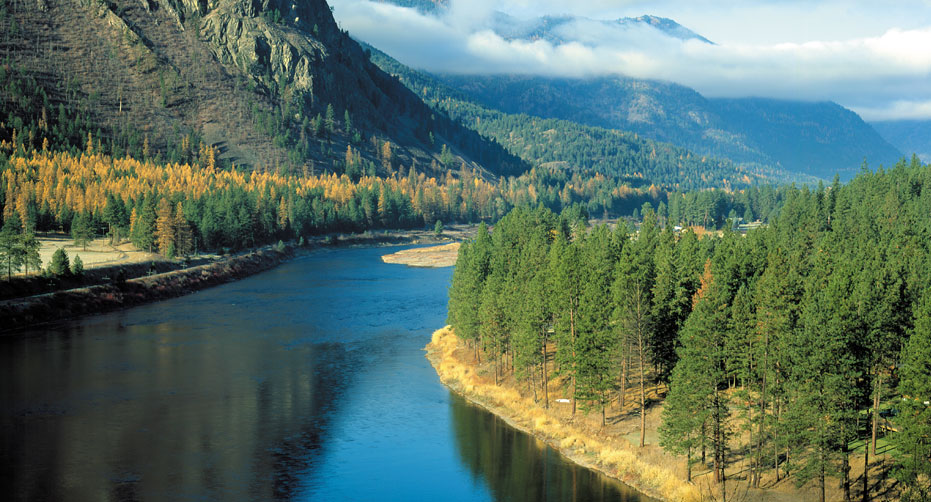
Update: In 2021, a local Montana ranching family bought the Dry Cottonwood Creek Ranch. Proceeds from the sale were returned to the Natural Resource Damage Program’s restoration fund. Conservation and recreational easements were put in place with the sale and we established the Dry Cottonwood Creek Field Center as an education and research hub.
What we’re learning from the monumental Superfund cleanup of the Upper Clark Fork River
Big yellow backhoes. Haul trucks barreling down make-shift roads. Raw dirt, gravel piles, and heaps of mine tailings. This is the scene on our ranch in the Upper Clark Fork. It’s also what gets us excited at the Clark Fork Coalition: the monumental cleanup of our river’s headwaters is in full swing!
Believe it or not, our ranch is also still a thriving cattle operation, construction equipment and all. Dry Cottonwood Creek Ranch is in the middle of the largest Superfund site in the West, and it’s the first private property undergoing cleanup of historic mining contamination. This watershed-scale project will ultimately heal the river, make ranchlands more productive, restore fish and wildlife habitat, and benefit the many people who depend upon the Clark Fork.
 Last summer, this heavy machinery broke ground on our ranch near Deer Lodge to begin removing truckloads of mine waste from four meandering miles of the Clark Fork River. Although we’ve been eagerly anticipating the arrival of clanking machinery since we bought the ranch with two conservation partners in 2005, it’s still terrifying to see our verdant floodplain bulldozed.
Last summer, this heavy machinery broke ground on our ranch near Deer Lodge to begin removing truckloads of mine waste from four meandering miles of the Clark Fork River. Although we’ve been eagerly anticipating the arrival of clanking machinery since we bought the ranch with two conservation partners in 2005, it’s still terrifying to see our verdant floodplain bulldozed.
But that’s exactly why we bought the place. The metals-polluted floodplain in our river’s headwaters—contaminated by mine tailings that washed down from Butte in the record flood of 1908—needed help. We realized that this Superfund cleanup was the chance to restore the river, but that it would also be unique since most of the contamination is on private ranchlands.
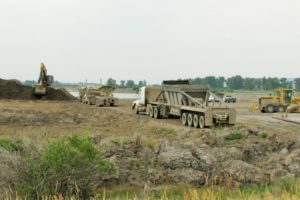 We knew that if the cleanup didn’t work for ranchers, it wouldn’t work period. Not a risk we wanted to take, with only one shot to restore the river to full health. We decided that securing buy-in from the hundreds of ranchers who live along the river’s banks would be more likely if a “guinea pig” first demonstrated how such a large cleanup could coexist with a working cattle operation.
We knew that if the cleanup didn’t work for ranchers, it wouldn’t work period. Not a risk we wanted to take, with only one shot to restore the river to full health. We decided that securing buy-in from the hundreds of ranchers who live along the river’s banks would be more likely if a “guinea pig” first demonstrated how such a large cleanup could coexist with a working cattle operation.
So, when the opportunity arose a decade ago, we became that guinea pig. The Coalition and our partners bought Dry Cottonwood Creek Ranch with the twin goals of: 1) ensuring a top-notch cleanup of the river and floodplain, and 2) figuring out how to make the cleanup work for the landowners along the river.
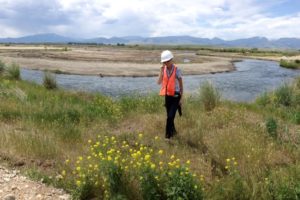 Today, we’re halfway toward meeting our goals. The cleanup of Dry Cottonwood Creek Ranch is at the midway point. In total, BP-ARCO (through a watershed-scale Superfund lawsuit settlement with the State of Montana) is funding $10 million worth of construction and restoration work on our property alone.
Today, we’re halfway toward meeting our goals. The cleanup of Dry Cottonwood Creek Ranch is at the midway point. In total, BP-ARCO (through a watershed-scale Superfund lawsuit settlement with the State of Montana) is funding $10 million worth of construction and restoration work on our property alone.
Here at the halfway point, with nothing but willow sticks protruding from raw-looking riverbanks, we take comfort from the success we’ve seen at other major river restoration sites. As a conservation group, we’ve learned from large-scale projects at Silver Bow Creek, the Jocko River, and Milltown that when contamination is removed, the floodplain contoured just right, and vegetation planted carefully, the river looks lush and healthy again in just a couple of years.
 We’ve also taken plenty of notes about cleanup from our unique vantage point as a rancher. As Maggie Schmidt, our ranch manager, says, “We definitely learned some lessons that we can share with other landowners!” Maggie and all Coalition staff have been transparent in sharing our experiences—good and bad—with neighbors to help them avoid the same problems before they ink their contracts with the Department of Environmental Quality. On the flip side, DEQ has also learned from us about what does and doesn’t work on a ranch, which we hope will benefit other landowners down the road.
We’ve also taken plenty of notes about cleanup from our unique vantage point as a rancher. As Maggie Schmidt, our ranch manager, says, “We definitely learned some lessons that we can share with other landowners!” Maggie and all Coalition staff have been transparent in sharing our experiences—good and bad—with neighbors to help them avoid the same problems before they ink their contracts with the Department of Environmental Quality. On the flip side, DEQ has also learned from us about what does and doesn’t work on a ranch, which we hope will benefit other landowners down the road.
Like all big projects, the cleanup at Dry Cottonwood Creek Ranch faced its share of challenges over the past year. Luckily, we’ve been able to work cooperatively with the contractors and DEQ to turn some of these challenges into opportunities. For instance:
- We built permanent stock tanks—supplied by groundwater wells and financed by DEQ and the contractor—to provide water for our livestock since they lost access to the river during cleanup. These tanks will also help the river in the long run by keeping livestock from trampling the newly restored banks.
- We sold gravel from our property to the construction contractors, providing extra income to the ranch. Those “borrow” areas will be restored as wetlands, providing diverse habitat for birds and wildlife.
- We traded a conservation servitude (similar to an easement) in return for restoration work on two spring creeks by working with the Natural Resource Damage Program. This will improve water quality and habitat long into the future.
- We are compensated by DEQ when we lose productive grazing or haying ground to construction work, which helps us maintain the bottom line of the agricultural operation.
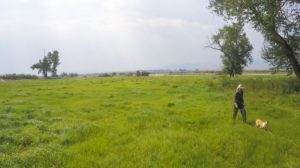
This work on our ranch is just the beginning of a multi-year, multi-ranch, multi-million-dollar cleanup of the entire Upper Clark Fork watershed. Superfund cleanup launched in 2013 along 43 miles of the river, and is expected to continue for 15 years. The work is divided into 22 “phases” of varying length based on property boundaries, from just below Warm Springs Ponds to Garrison Junction.
Here’s an update on where Superfund work stands along the river:
- Phase 1, just below Warm Springs Ponds: The first phase of Superfund cleanup on 1.6 river-miles of state-owned land (where the Clark Fork officially begins) was completed in 2014. This summer, it looks verdant and green with willows and native grasses.
- Phase 2, upstream of Perkins Lane: Cleanup began in July on 1.9 miles of river on a mix of state and private land.
- Phases 3 and 4, Perkins Lane to Galen Road: Sampling of this stretch of river finished earlier this year, and DEQ is now designing the cleanup project here.
- Phases 5 and 6, Galen Road to Racetrack exit: Construction began in 2014 on our Dry Cottonwood Creek Ranch and will be finished in early 2016.
- Phase 7, Paracini Pond area: Sampling is complete on this parcel of state land, and a preliminary cleanup design is now in place.
- Phases 15 and 16, Grant-Kohrs Ranch National Park: The preliminary designs are complete, and they will be finalized later this year with cleanup slated for 2016.
Thanks to all of you who are a part of this inspiring story. We feel privileged to be the first private ranch undergoing cleanup. Stay tuned as we continue to share the lessons learned from this incredible opportunity to bring our river and our land back to life. Meanwhile, give us a shout if you have any questions or want to schedule a tour of the ranch.
2017 update on the cleanup (CFC newsletter – see pg. 12)
Learn more about the Upper Clark Fork

< Back to blog
